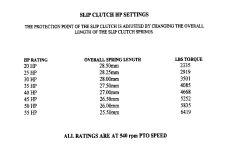Farmwithjunk
Super Member
3RRL said:Does your tractor have a 2 speed PTO ... maybe 540 and 720? If so, you could put it in 720 PTO speed and run at lower engine rpm if your tractor has the hp to run the mower. That's what I do. For example, my tractor engine runs at 2300 rpm to get 540 PTO rpm. But when I put the PTO in the 720 range, I can run the engine at 1725 rpm and generate 540 PTO rpm that way. In your case (if you have a 720 PTO range) you could run your engine at 1950 rpm to get 540 PTO rpm. (I used 2600 engine rpm to get 540 PTO rpm), then assumed you have a 720 PTO speed.
Advantages for me are:
- less engine rpm so less fuel use
- my peak torque falls right at that (1725) rpm range so little "engine bog down"
- I can navigate terrain at a slower speed in each gear since my engine rpm's are less
- less noise and vibration
- less wear and tear on the engine and drive train ... regardless that you can run a diesel at full rpm
As usual, others may disagree, but that's what I do.
So, do you have a 2 speed PTO?
My older tractors pre-date the relatively new concept of 2-speed pto's (Not including the idea of 1000rpm pto, but that applies to larger tractors) My 150 Massey has the 540rpm and "ground speed" pto option, but that's a completely different concept altogether.
The 6430 Deere has enough of a mower behind it that it needs full rated rpms in all the mowing conditions where we've been using it.
A good many larger tractors (larger than most subs and compacts) will have engines with more cubes and a little wider powerband. They will facilitate using them at various engine speeds and still have enough hp/torque to do their thing without running at full "pto rated rpms". Regardless of the fact that some people just don't see it that way, a great deal of the time, mowing conditions will allow lower blade speeds and still you'll get the quality of cut that higher speeds will offer. In some conditions slower blade speed simply works BETTER. (Where trash and hidden obsticals are present comes to mine first)
As a generality, most manufacturers will suggest running at full rated rpms as a way of preventing the user from lugging their diesel engines. That's NOT GOOD on diesels. In no event would I suggest running any diesel slow enough to cause it to lug down.
I have a New Holland 451 sickel bar mower that has a "better idea"! They have (I hope I can spell this'n right) a variable speed sheave (pulley) on the belt drive that allows you to change it to "over-drive" the mower. That allows up to a 33% reduction in pto speed, while all along letting the mower run at the same speed as it would with a constant 540 rpm pto speed. Combine that with the fact that it can be used with cutterbar speeds just under "full tilt", and a 451 user can run their engine at just over 1/2 the rated pto speed. Sickel bars don't require very much hp. This option lets you cruise around the hayfield with your engine barely above idle and still get the job done.
As our mowing business takes off, I'm shopping for ideas to equip it better for more economic operation. (Yes, I'm a mizer) One idea I'm really interested in is a hydraulic driven mower. (Alamo Group.....Rhino) Most larger modern tractors will supply enough hydraulic flow and pressure at mid rpms to run these mowers at full speed. With diesel not too far off gas prices of more than $3 a gallon, it wouldn't take long to realize a significant savings I'd suspect.
Simply running my fuel mizer 150 Massey at a reduced engine speed will save me a quite a bit of fuel over the course of an 8 hour day of bush hogging. (At full pto rated rpms this little gem will power a 6' mower in heavy weeds, cutting 2-1/2+ acres per hour, and not burn more than 3/4 gallon per hour. And we're talking 1960's technology here too)

